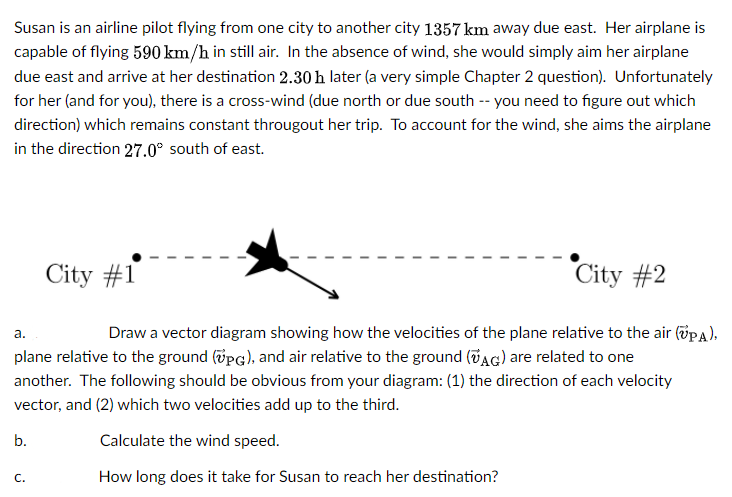Susan is an airline pilot flying from one city to another city 1357 km away due east. Her airplane is capable of flying 590 km/h in still air. In the absence of wind, she would simply aim her airplane due east and arrive at her destination 2.30 h later (a very simple Chapter 2 question). Unfortunately for her (and for you), there is a cross-wind (due north or due south -- you need to figure out which direction) which remains constant througout her trip. To account for the wind, she aims the airplane in the direction 27.0° south of east. City #1 City #2 Draw a vector diagram showing how the velocities of the plane relative to the air (õpA), а. plane relative to the ground (õpg), and air relative to the ground (VAG) are related to one another. The following should be obvious from your diagram: (1) the direction of each velocity vector, and (2) which two velocities add up to the third. b. Calculate the wind speed. C. How long does it take for Susan to reach her destination?
Susan is an airline pilot flying from one city to another city 1357 km away due east. Her airplane is capable of flying 590 km/h in still air. In the absence of wind, she would simply aim her airplane due east and arrive at her destination 2.30 h later (a very simple Chapter 2 question). Unfortunately for her (and for you), there is a cross-wind (due north or due south -- you need to figure out which direction) which remains constant througout her trip. To account for the wind, she aims the airplane in the direction 27.0° south of east. City #1 City #2 Draw a vector diagram showing how the velocities of the plane relative to the air (õpA), а. plane relative to the ground (õpg), and air relative to the ground (VAG) are related to one another. The following should be obvious from your diagram: (1) the direction of each velocity vector, and (2) which two velocities add up to the third. b. Calculate the wind speed. C. How long does it take for Susan to reach her destination?
Principles of Physics: A Calculus-Based Text
5th Edition
ISBN:9781133104261
Author:Raymond A. Serway, John W. Jewett
Publisher:Raymond A. Serway, John W. Jewett
Chapter3: Motion In Two Dimensions
Section: Chapter Questions
Problem 9P
Related questions
Question

Transcribed Image Text:Susan is an airline pilot flying from one city to another city 1357 km away due east. Her airplane is
capable of flying 590 km/h in still air. In the absence of wind, she would simply aim her airplane
due east and arrive at her destination 2.30 h later (a very simple Chapter 2 question). Unfortunately
for her (and for you), there is a cross-wind (due north or due south -- you need to figure out which
direction) which remains constant througout her trip. To account for the wind, she aims the airplane
in the direction 27.0° south of east.
City #1
City #2
Draw a vector diagram showing how the velocities of the plane relative to the air (õpA),
а.
plane relative to the ground (õpg), and air relative to the ground (VAG) are related to one
another. The following should be obvious from your diagram: (1) the direction of each velocity
vector, and (2) which two velocities add up to the third.
b.
Calculate the wind speed.
C.
How long does it take for Susan to reach her destination?
Expert Solution
This question has been solved!
Explore an expertly crafted, step-by-step solution for a thorough understanding of key concepts.
This is a popular solution!
Trending now
This is a popular solution!
Step by step
Solved in 2 steps with 1 images

Knowledge Booster
Learn more about
Need a deep-dive on the concept behind this application? Look no further. Learn more about this topic, physics and related others by exploring similar questions and additional content below.Recommended textbooks for you

Principles of Physics: A Calculus-Based Text
Physics
ISBN:
9781133104261
Author:
Raymond A. Serway, John W. Jewett
Publisher:
Cengage Learning

Principles of Physics: A Calculus-Based Text
Physics
ISBN:
9781133104261
Author:
Raymond A. Serway, John W. Jewett
Publisher:
Cengage Learning